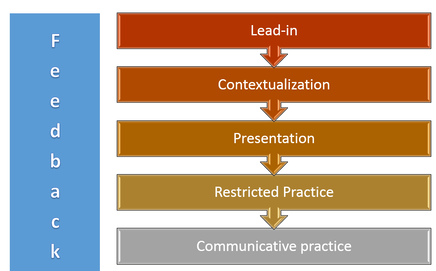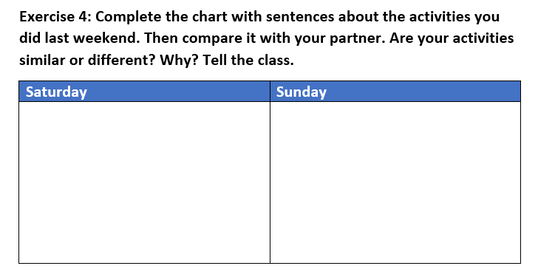3.5. A model to teach Grammar
3.5.1. Lead-in
The first step in teaching a grammar lesson should be a quick introduction to its theme. In this stage the teacher may want to create students interest on the context or the target grammar students will have to deal with later. This can be done through the presentation of pictures, videos, games, provocative questions, recall of previous knowledge and others. In some cases, this stage could be omitted but it is highly recommendable to have one. In this example, the teacher asks students to think about common weekend activities like watching Netflix.
The first step in teaching a grammar lesson should be a quick introduction to its theme. In this stage the teacher may want to create students interest on the context or the target grammar students will have to deal with later. This can be done through the presentation of pictures, videos, games, provocative questions, recall of previous knowledge and others. In some cases, this stage could be omitted but it is highly recommendable to have one. In this example, the teacher asks students to think about common weekend activities like watching Netflix.
3.5.1. Contextualization
In this second stage, teachers establish the context in which the target grammar usually arise naturally. It is in this stage when the target grammar is presented embedded in some kind of text. Options to present the target grammar into context are readings, conversations, short stories, audios, videos, etc. Usually the target grammar examples are highlighted in the same text, or it is the teacher the one one highlights the grammar samples by ‘isolating’ them from the rest of the text.
In this second stage, teachers establish the context in which the target grammar usually arise naturally. It is in this stage when the target grammar is presented embedded in some kind of text. Options to present the target grammar into context are readings, conversations, short stories, audios, videos, etc. Usually the target grammar examples are highlighted in the same text, or it is the teacher the one one highlights the grammar samples by ‘isolating’ them from the rest of the text.
3.5.2. Presenting grammar
It is at the stage when the teacher uses the inductive or deductive approach to teach grammar. The decision of using one or the other will depend on the complexity of the target grammar, students’ preferences and even the need to provide variety in the language classroom.
If the teacher uses a deductive approach, he/she will explain the form, meaning, and use of the target grammar. Probably the use of substitution charts would be of great help.
If the teacher decides to use an inductive approach, he/she will guide students to discover the grammar rules by asking questions that will help them discover the grammar form, meaning and use. Quick exercises like completing charts, or classifying sentences can also be of great help.
Whether the teacher uses and inductive or deductive approach, asking questions like the ones exemplified under guided discovery are very helpful.
It is at the stage when the teacher uses the inductive or deductive approach to teach grammar. The decision of using one or the other will depend on the complexity of the target grammar, students’ preferences and even the need to provide variety in the language classroom.
If the teacher uses a deductive approach, he/she will explain the form, meaning, and use of the target grammar. Probably the use of substitution charts would be of great help.
If the teacher decides to use an inductive approach, he/she will guide students to discover the grammar rules by asking questions that will help them discover the grammar form, meaning and use. Quick exercises like completing charts, or classifying sentences can also be of great help.
Whether the teacher uses and inductive or deductive approach, asking questions like the ones exemplified under guided discovery are very helpful.
3.5.3. Restricted (Controlled) Practice
I this set of practice exercises, student have to complete sentences, identify correct verb forms, distinguish sentences actual meaning or categorize sentences according to their level of formality and pragmatic use. In this stage, students still do not produce original language on their own and communication is kept to a minimum.
I this set of practice exercises, student have to complete sentences, identify correct verb forms, distinguish sentences actual meaning or categorize sentences according to their level of formality and pragmatic use. In this stage, students still do not produce original language on their own and communication is kept to a minimum.
3.5.4. Communicative Practice
Right after students had had the opportunity to practice the grammar dimensions in a controlled practice exercise, they need to practice activities which are more communicative. These type of activities aim at helping develop fluency in the use of the target grammar and give students room to personañlize their learning through speaking or writing about their personal opinions, experiences or information. It is possible to mention some principles of communicative activities as follows:
Although these types of grammar practice activities are pedagogical, they should give student some sort of preparation to confront a real communicative situation.
Right after students had had the opportunity to practice the grammar dimensions in a controlled practice exercise, they need to practice activities which are more communicative. These type of activities aim at helping develop fluency in the use of the target grammar and give students room to personañlize their learning through speaking or writing about their personal opinions, experiences or information. It is possible to mention some principles of communicative activities as follows:
- Learners use the language in context and with a clear purpose.
- Language Functions are more important than isolated grammar.
- Learners have a clear desire to communicate.
- Learners are involved in real or realistic communication.
- Learners focus on content rather than in form per se.
Although these types of grammar practice activities are pedagogical, they should give student some sort of preparation to confront a real communicative situation.
3.5.5. Feedback.
Feedback should be present throughout the lesson grammar. It should happen while students are noticing the grammar target and during practice activities. During the restricted practice stage, feedback is normally clear and straightforward. The teacher basically corrects students mistakes as they should be very evident and the possible responses to the exercises are clear-cut. During more communicative activities, teachers might want to correct the most generalized errors after the activity is over. For this to happen, the teacher could collect systematically errors students are making during their completion of the communicative activity.
Feedback should be present throughout the lesson grammar. It should happen while students are noticing the grammar target and during practice activities. During the restricted practice stage, feedback is normally clear and straightforward. The teacher basically corrects students mistakes as they should be very evident and the possible responses to the exercises are clear-cut. During more communicative activities, teachers might want to correct the most generalized errors after the activity is over. For this to happen, the teacher could collect systematically errors students are making during their completion of the communicative activity.








